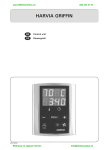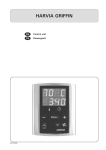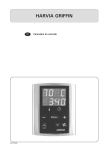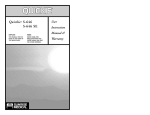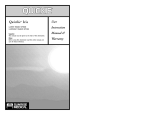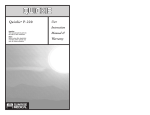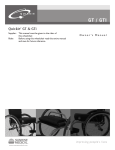Download WX310-350 User Manual - Daramdale Farm Implements Pty Ltd
Transcript
LOG SPLITTER WX310 OPERATOR’S MANUAL AND PARTS LISTING 1 1 INTRODUCTION This equipment has been designed and manufactured to meet the needs of a discriminating buyer for the efficient splitting of logs. Safe, efficient and trouble free operation of your Log splitter requires that you and anyone else who will be operating or maintaining the machine, read and understand the Safety, Operation, Maintenance and Trouble Shooting information contained within the Operator's Manual. This manual covers the 3 Point Hitch Log splitters, models WX310,WX350. Keep this manual handy for frequent reference and to pass on to new operators or owners. Call your dealer, distributor or the factory if you need assistance, information or additional copies of the manuals. OPERATOR ORIENTATION - The directions left, right, front and rear, as mentioned throughout this manual, are as seen from the driver's seat and facing in the direction of travel. 2 SAFETY SAFETY ALERT SYMBOL This Safety Alert symbol means ATTENTION! BECOME ALERT YOUR SAFETY IS INVOLVED! The Safety Alert symbol identifies important safety messages on the Log splitter and in the manual. When you see this symbol, be alert to the possibility of personal injury or death. Follow the instructions in the safety message. SIGNAL WORDS:Note the use of the signal words DANGER, WARNING and CAUTION with the safety messages. The appropriate signal word for each message has been selected using the following guide-lines: DANGER - Indicates an imminently hazardous situation that, if not avoided, will result in death or serious injury. This signal word is to be limited to the most extreme situations typically for machine components which, for functional purposes, cannot be guarded. WARNING - Indicates a potentially hazardous situation that, if not avoided, could result in death or serious injury, and includes hazards that are exposed when guards are removed. It may also be used to alert against unsafe practices. CAUTION - Indicates a potentially hazardous situation that, if not avoided, may result in minor or moderate injury. It may also be used to alert against unsafe practices. SAFETY YOU are responsible for the SAFE operation and maintenance of your Trailer Wood-splitter. YOU must ensure that you and anyone else who is going to operate, maintain or work around the Log splitter be familiar with the operating and maintenance procedures and related SAFETY information contained in this manual. This manual will take you step-by-step through your working day and alerts you to all good safety practices that should be adhered to while operating the Log splitter. Remember, YOU are the key to safety. Good safety practices not only protect you but also the people around you. Make these practices a working part of your safety program. Be certain that EVERYONE operating this equipment is familiar with the recommended operating and maintenance procedures and follows all the safety precautions. Most accidents can be prevented. Do not risk injury or death by ignoring good safety practices. 2 * Log splitter owners must give operating instructions to operators or employees before allowing them to operate the machine, and at least annually. * The most important safety feature on this equipment is a SAFE operator. It is the operator’s responsibility to read and understand ALL Safety and Operating instructions in the manual and to follow these. Most accidents can be avoided. * A person who has not read and understood all operating and safety instructions is not qualified to operate the machine. An untrained operator exposes himself and bystanders to possible serious injury or death. * Do not modify the equipment in any way. Unauthorized modification may impair the function and/ or safety and could affect the life of the equipment. * Think SAFETY! Work SAFELY! 2.1 GENERAL SAFETY 1. Read and understand the Operator’s Manual and all safety signs before operating, maintaining, adjusting or unplugging the Log splitter. 2. Have a first-aid kit available for use should the need arise and know how to use it. 3. Have a fire extinguisher available for use should the need arise and know how to use it. 4. Do not allow riders. 5. Wear appropriate protective gear. This list includes but is not limited to: A hard hat ;Protective shoes with slip resistant soles;.Protective goggles, glasses or face shield; Heavy gloves; Protective clothing. 6. Install and secure all guards before starting. 7. Wear suitable ear protection for prolonged exposure to excessive noise. 8. Place all controls in neutral, stop engine, set park brake, remove ignition key and wait for all moving parts to stop before servicing, adjusting, repairing or unplugging. 9. Clear the area of people, especially small children, before starting. 10. Review safety related items annually with all personnel who will operating or maintaining the Log splitter. 3 2.2 EQUIPMENT SAFETY GUIDELINES 1. Safety of the operator and bystanders is one of the main concerns in designing and developing a machine. However, every year many accidents occur which could have been avoided by a few seconds of thought and a more careful approach to handling equipment. You, the operator, can avoid many accidents by observing the following precautions in this section. To avoid personal injury or death, study the following precautions and insist those working with you, or for you, follow them. 2. In order to provide a better view, certain photographs or illustrations in this manual may show an assembly with a safety shield removed. However, equipment should never be operated in this condition. Keep all shields in place. If shield removal becomes necessary for repairs, replace the shield prior to use. 3. Replace any safety sign or instruction sign that is not readable or is missing. 4. Never use alcoholic beverages or drugs which can hinder alertness or coordination while operating this equipment. Consult your doctor about operating this machine while taking prescription medications. 5. Under no circumstances should young children be allowed to work with this equipment. Do not allow persons to operate or assemble this unit until they have read this manual and have developed a thorough understanding of the safety precautions and of how it works. Review the safety instructions with all users annually. 6. This equipment is dangerous to children and persons unfamiliar with its operation. The operator should be a responsible, properly trained and physically able person familiar with farm machinery and trained in this equipment's operations. If the elderly are assisting with work, their physical limitations need to be recognized and accommodated. 7. Use a tractor equipped with a Roll Over Protective Structure (ROPS) and a seat belt. 8. Never exceed the limits of a piece of machinery. If its ability to do a job, or to do so safely, is in question - DON'T TRY IT. 9. Do not modify the equipment in any way. Unauthorized modification result in serious injury or death and may impair the function and life of the equipment. 10. In addition to the design and configuration of this implement, including Safety Signs and Safety Equipment, hazard control and accident prevention are dependent upon the awareness, concern, prudence, and proper training of personnel involved in the operation, transport, maintenance, and storage of the machine. Refer also to Safety Messages and operation instruction in each of the appropriate sections of the Tractor and machine Manuals. Pay close attention to the Safety Signs affixed to the tractor and the machine. 2.3 SAFETY TRAINING 1. Safety is a primary concern in the design and manufacture of our products. Unfortunately, our efforts to provide safe equipment can be wiped out by a single careless act of an operator or bystander. 2. In addition to the design and configuration of equipment, hazard control and accident prevention are dependent upon the awareness, concern, prudence and proper training of personnel involved in the operation, transport, maintenance and storage of this equipment. 3. It has been said, "The best safety feature is an informed, careful operator." We ask you to be 4 that kind of an operator. It is the operator's responsibility to read and understand ALL Safety and Operating instructions in the manual and to follow these. Accidents can be avoided. 4. Working with unfamiliar equipment can lead to careless injuries. Read this manual, and the manual for your tractor, before assembly or operating, to acquaint yourself with the machines. If this machine is used by any person other than yourself, or is loaned or rented, it is the machine owner's responsibility to make certain that the operator, prior to operating: a. Reads and understands the operator's manuals. b. Is instructed in safe and proper use. 5. Know your controls and how to stop tractor, engine, and machine quickly in an emergency Read this manual and the one provided with your tractor. 6. Train all new personnel and review instructions frequently with existing workers. Be certain only a properly trained and physically able person will operate the machinery. A person who has not read and understood all operating and safety instructions is not qualified to operate the machine. An untrained operator exposes himself and bystanders to possible serious injury or death. If the elderly are assisting with farm work, their physical limitations need to be recognized and accommodated. 2.4 SAFETY SIGNS 1. Keep safety signs clean and legible at all times. 2. Replace safety signs that are missing or have become illegible. 3. Replaced parts that displayed a safety sign should also display the current sign. 4. Safety signs are available from your authorized Distributor or Dealer Parts Department or the factory. How to Install Safety Signs: * Be sure that the installation area is clean and dry. * Be sure temperature is above 50°F (10°C). * Determine exact position before you remove the backing paper. * Remove the smallest portion of the split backing paper. * Align the sign over the specified area and carefully press the small portion with the exposed sticky backing in place. * Slowly peel back the remaining paper and carefully smooth the remaining portion of the sign in place. * Small air pockets can be pierced with a pin and smoothed out using the piece of sign backing paper. 2.5 PREPARATION 1. Never operate the tractor and machine until you have read and completely understand this manual, the Tractor and Engine Operator's Manual, and each of the Safety Messages found on the safety signs on the tractor, engine and machine. 2. Personal protection equipment including hard hat, safety glasses, safety shoes, and gloves are recommended during assembly, installation, operation, adjustment, maintaining, repairing, 5 removal, or moving the implement. Do not allow long hair, loose fitting clothing or jewelry to be around equipment. 3. PROLONGED EXPOSURE TO LOUD NOISE MAY CAUSE PERMANENT HEARING LOSS! Tractors with or without equipment attached can often be noisy enough to cause permanent,partial hearing loss. We recommend that you wear hearing protection on a full-time basis if the noise in the Operator's position exceeds 80db. Noise over 85db on a long-term basis can cause severe hearing loss. Noise over 90db adjacent to the Operator over a long-term basis may cause permanent, total hearing loss. NOTE: Hearing loss from loud noise (from tractors, chain saws, radios, and other such sources close to the ear) is cumulative over a lifetime without hope of natural recovery. 4. Operate the machine only with a tractor equipped with an approved Roll-Over-Protective Structure (ROPS). Always wear your seat belt. Serious injury or even death could result from falling off the tractor ---particularly during a turnover when the operator could be pinned under the ROPS or the tractor. 5. Clear working area of stones, branches or hidden obstacles that might be hooked or snagged, causing injury or damage. 6. Operate only in daylight or good artificial light. 7. Be sure machine is properly mounted, adjusted and in good operating condition. 8. Ensure that all safety shielding and safety signs are properly installed and in good condition. 2.6 OPERATING SAFETY 1. Please remember it is important that you read and heed the safety signs on the Log splitter. Clean or replace all safety signs if they cannot be clearly read and understood. They are there for your safety, as well as the safety of others. The safe use of this machine is strictly up to you, the operator. 2. All things with moving parts are potentially hazardous. There is no substitute for a cautious, safe-minded operator who recognizes potential hazards and follows reasonable safety practices. The manufacturer has designed this Log splitter to be used with all its safety equipment properly attached, to minimize the chance of accidents. Study this manual to make sure you have all safety equipment attached. 3. If a safety shield or guard is removed for any reason, it must be replaced before the machine is again operated. 4. Personal protection equipment including hard hat, safety glasses, hearing protection, safety shoes, and tight gloves are recommended during assembly, installation, operation, adjustment, maintaining, repairing, removal, or moving. Do not allow long hair, loose fitting clothing, or jewelry to be around moving parts. 5. Always use two people to handle heavy, unwieldy components during assembly, installation, removal or moving. 6. Never place any part of your body, fingers, hands, feet, etc. where it would be in danger if movement should occur during assembly, installation, operation, maintaining, repairing, removal or moving. Keep others away. 7. Do not allow bystanders within 20 feet of machine during operation. Wood chips can fly out and injure others. 6 8. Do not step over or straddle splitter during operation. 9. Do not try to split more than one log at a time. The extra log can fly out and cause injury. 10. Keep your fingers and hands away from cracks in the log that can open while splitting. 11. Always load logs by holding on the sides, not the top and bottom. 12. Do not load the splitter when the wedge is in motion. 13. Do not try to split logs across the grain. Some kinds can burst or splinter and fly out of machine causing injury. 14. For uneven cut logs, always place the wide end down and the most square end against the splitting wedge. 15. Never use alcoholic beverages or drugs which can hinder alertness or coordination while operating this equipment. Consult your doctor about operating this machine while taking prescription medications. 16. Do not allow riders on the machine or tractor at any time. There is no safe place for any riders. 17. Before you operate the machine, check over all pins, bolts, connections and hydraulic components to be sure all are securely in place and tight. Tighten or replace any leaking, damaged or worn parts immediately. 18. Do not allow anyone who is not familiar with the safety rules and operation instructions to use this machine. 19. Never allow children to operate or be around this machine. 20. Do not operate on slopes or hillsides. Sloping terrain can cause logs to roll or slip. 21. Clear the work area of objects which might be picked up and snagged or entangled in the machine. Do not operate on slippery, wet, muddy or icy surfaces. Good footing prevents slipping and tripping. 2.7 HYDRAULIC SAFETY 1. Make sure that all the components in the hydraulic system are kept in good condition and are clean. 2. Replace any worn, cut, abraded, flattened or crimped hoses and metal lines. 3. Stop engine or motor, disconnect spark plug wire or unplug power cord, and wait for all moving parts to stop before servicing, adjusting, repairing or cleaning. 4. Do not attempt any makeshift repairs to the hydraulic lines, fittings or hoses by using tapes, clamps or cements. The hydraulic system operates under extremely high-pressure. Such repairs will fail suddenly and create a hazardous and unsafe condition. 5. Wear proper hand and eye protection when searching for a high-pressure hydraulic leak. Use a piece of wood or cardboard as a backstop instead of hands to isolate and identify a leak. 6. If injured by a concentrated high-pressure stream of hydraulic fluid, seek medical attention immediately. Serious infection or toxic reaction can develop from hydraulic fluid piercing the skin surface. 7. Before applying pressure to the system, make sure all components are tight and that lines, hoses and couplings are not damaged. 7 2.8 STORAGE SAFETY 1. Store the unit in an area away from human activity. 2. Do not permit children to play on or around the stored machine. 3. Store the unit in a dry, level area. Support the frame with planks if required. 2.9 TRANSPORT SAFETY 1. Comply with state and local laws governing highway safety and movement of machinery on public roads. 2. The use of flashing amber lights is acceptable in most localities. However, some localities prohibit their use. Local laws should be checked for all highway lighting and marking requirements. 3. At all times, when driving the tractor and equipment on the road or highway under 20 mph (32 kph) use lashing amber warning lights and a slow moving vehicle (SMV) identification emblem. Do not exceed 20 mph (32 kph). Reduce speed on rough roads and surfaces. 4. Plan your route to avoid heavy traffic. 5. Be sure the trailer is hitched positively to the towing vehicle and a retainer is used through the hitch coupler. Always attach a safety chain between the hitch and the towing vehicle. 6. Always install transport locks, pins or brackets before transporting. 7. Do not drink and drive. 8. Be a safe and courteous driver. Always yield to oncoming traffic in all situations, including narrow bridges, intersections, etc. Watch for traffic when operating near or crossing roadways. 9. Never allow riders on either tractor or machine. 2.10 MAINTENANCE SAFETY 1. Good maintenance is your responsibility. Poor maintenance is an invitation to trouble. 2. Follow good shop practices. - Keep service area clean and dry. - Be sure electrical outlets and tools are properly grounded. - Use adequate light for the job at hand. 3. Make sure there is plenty of ventilation. Never operate the engine of the towing vehicle in a closed building. The exhaust fumes may cause asphyxiation. 4. Before working on this machine, shut off the engine, set the brakes, and remove the ignition keys. 5. Never work under equipment unless it is blocked securely. 6. Use personal protection devices such as eye, hand and hearing protectors, when performing any service or maintenance work. 7. Where replacement parts are necessary for periodic maintenance and servicing, genuine factory replacement parts must be used to restore your equipment to original specifications. The 8 manufacturer will not be responsible for injuries or damages caused by use of unapproved parts and/or accessories. 8. A fire extinguisher and first aid kit should be kept readily accessible while performing maintenance on this equipment. 9. Periodically tighten all bolts, nuts and screws and check that all cotter pins are properly installed to ensure unit is in a safe condition. 10. When completing a maintenance or service function, make sure all safety shields and devices are installed before placing unit in service. 9 3 SAFETY SIGN LOCATIONS The types of safety signs and locations on the equipment are shown in the illustration below. Good safety requires that you familiarize yourself with the various safety signs, the type of warning and the area, or particular function related to that area, that requires your SAFETY AWARENESS. REMEMBER - If safety signs have been damaged, removed, become illegible or parts replaced without signs, new signs must be applied. New signs are available from your authorized dealer. 10 4 OPERATION OPERATING SAFETY * Read and understand the Operator’s Manual and all safety signs before operating, servicing, adjusting, repairing or unplugging. * Do not allow riders. * Install and secure all guards and shields before starting or operating. * Keep hands, feet, hair and clothing away from moving parts. * Place all controls in neutral, stop tractor engine, set park brake, remove ignition key and wait for all moving parts to stop before servicing, adjusting, repairing or unplugging. * Place all tractor and machine controls in neutral before starting. * Always wear the appropriate personal safety equipment when operating splitter including but not limited to hard hat, safety shoes, face shield and heavy gloves. * Clear the area of bystanders, especially small children, before starting. * Do not operate on slopes or side hills. * Keep working area clean, neat and dry to prevent slipping and tripping. * Keep all mechanical and hydraulic components in good condition. Do not operate with leaks or damaged components. * Load splitter by holding logs on the side rather than the top and bottom. * Do not split wood across the grain. * Review safety instructions with all operators annually. 4.1 TO THE NEW OPERATOR OR OWNER The Log splitter is designed to split any kind of wood or log. Be familiar with the machine before starting. In addition to the design and configuration of equipment, hazard control and accident prevention are dependent upon the awareness, concern, prudence and proper training of personnel involved in the operation, transport, maintenance and storage of equipment. It is the responsibility of the owner or operator to read this manual and to train all other operators before they start working with the machine. Follow all safety instructions exactly. Safety is everyone's business. By following recommended procedures, a safe working environment is provided for the operator, bystanders and the area around the work site. Untrained operators are not qualified to operate the machine. Many features incorporated into this machine are the result of suggestions made by customers like you. Read this manual carefully to learn how to operate the machine safely and how to set it to provide maximum field efficiency. By following the operating instructions in conjunction with a good maintenance program, your Log splitter will provide many years of trouble-free service. 11 4.2 MACHINE COMPONENTS The 3 Point Hitch Log splitter consists of a wedge on the end of a hydraulic cylinder for splitting wood or logs. Hydraulic power from the tractor is routed through a double acting valve to control the cylinder position. 4.3 MACHINE BREAK-IN Although there are no operational restrictions on the Log splitter when used for the first time, it is recommended that the following mechanical items be checked: A. After Operating For 5 Hours: 1. Check all nuts, bolts and other fasteners. Tighten to their specified torque level. 2. Check hydraulic system for leaks. components. Tighten all leaking fittings and replace any leaking 3. Check machine fluid levels: Fuel, engine oil, and hydraulic oil reservoir. Top up as required. 4. Check for entangled material. Remove all entangled material before resuming work. 4.4 PRE-OPERATION CHECKLIST Efficient and safe operation of the Log splitter requires that each operator reads and understands the operating procedures and all related safety precautions outlined in this section. A pre-operation checklist is provided for the operator. It is important for both the personal safety and maintaining the good mechanical condition of the Log splitter that this checklist is followed.Before operating the machine and each time thereafter, the following areas should be checked off: 1. Use only a small Agricultural tractor of less than 100 horsepower on the machine. 2. Check that the machine is properly attached to the tractor. Be sure retainers are used on the mounting pins. 3. Be sure extra weights are mounted on the front of the tractor if required. 4. Check the wedge and block. Be sure they are not damaged or broken and is not badly worn. Repair or replace as required. 5. Check for entangled material. Remove this material. 6. Check for hydraulic leaks. Tighten fittings or replace components to stop leaks. 4.5 ASSEMBLY The machine is shipped from the factory in a partially disassembled configuration and attached to a pallet that provides easy moving and handling. Always use tools, equipment and fork lifts of appropriate size and capacity for the job. When the machine is shipped, follow this procedure when preparing for the customer: 1. Clear the area of bystanders, especially small children. 2. Remove the pallet tie-downs. 3. Use a forklift to lift the pallet/machine from the truck. Carry the load close to the ground as it is moved to the assembly area and positioned. 12 4. Remove the machine from the pallet. 5. Remove the package of control components from the frame. 6. Attach the lever to the control plunger and install the anchor pin and retainer. 7. Raise the lever into its vertical position and install the last anchor pin and retainer. IMPORTANT Be sure to spread the ends of the cotter pins retainers. 4.6 ATTACHING/UNHOOKING When attaching the machine to a tow unit, follow this procedure: 1. Clear the area of bystanders, especially small children. 2. Make sure there is enough room and clearance to safely back up to the splitter. 3. Place the tractor arms in their full sway position. 4. Back up slowly and align the lower link arms to the pins on the machine. 5. Connect the hydraulics: a. use a clean rag or paper towel to clean the dirt from couplers on the hose ends and the tractor. b. Connect the hoses to the tractor couplers. Be sure the couplers are securely seated. c. Route and secure the hoses along the hitch with clips, tape or plastic ties to prevent binding and pinching. 6. Start the engine and place the tractor hydraulic lever in detent. 7. Move the splitter hydraulic lever to move the wedge. 8. Reverse the hoses if the wedge does not move in the same direction as the hydraulic lever. 9. Slowly raise the machine through its operating range to make sure that there is no interference or binding. 10. Level the machine front and rear, and side to side using the jackscrew on the right arm and the turnbuckle on the top link. 11. To unhook from the tractor, reverse the above procedures. Always park the machine in a dry, lever area. 4.7 CONTROLS All controls are conveniently positioned next to where the operator would stand when loading or splitting wood. Review this section to familiarize yourself with the location and function of the control before starting. This 3-position spring-loaded-to-center neutral lever controls the flow of oil to the cylinder. Move the lever toward the base and hold for the cylinder ram to extend and split the wood. Move the lever away from the base to retract the cylinder ram. Release the lever, it will return to its centered neutral position The cylinder ram will stop moving. 13 4.8 FIELD OPERATION OPERATING SAFETY * Read and understand the Operator’s Manual and all safety signs before operating, servicing, adjusting, repairing or unplugging. * Do not allow riders. * Install and secure all guards and shields before starting or operating. * Keep hands, feet, hair and clothing away from moving parts. * Place all controls in neutral, stop tractor engine, set park brake, remove ignition key and wait for all moving parts to stop before servicing, adjusting, repairing or unplugging. * Place all tractor and machine controls in neutral before starting. * Always wear the appropriate personal safety equipment when operating splitter including but not limited to hard hat, safety shoes, face shield and heavy gloves. * Clear the area of bystanders, especially small children, before starting. * Do not operate on slopes or sidehills. * Keep working area clean, neat and dry to prevent slipping and tripping. * Keep all mechanical and hydraulic components in good condition. Do not operate with leaks or damaged components. * Load splitter by holding logs on the side rather than the top and bottom. * Do not split wood across the grain. * Review safety instructions with all operators annually. Each operator should review this section of the manual at the start of the season and as often as required to be familiar with the machine. When using, follow this procedure: 1. Clear the area of bystanders, especially small children. 2. Review and follow the Pre-Operation Checklist (Section 4.4). 3. Starting: a. Move tractor into its working position, lower the frame to the ground and set park brake. Be sure the working area is level, dry and free of obstructions. b. place the throttle in its mid-range position. c. place the working hydraulic circuit in detent. d. move the splitter wedge/cylinder to its fully retracted position. e. position log between the wedge and the base of the frame. f. move the hydraulic lever toward the base and hold it while the wedge moves through the log. g. release the lever when the log splits into 2 pieces or the wedge reaches the base and the wedge will stop. h. move the lever in the fully UP direction into detent. Release the lever and it will be in detent until the ram reaches the end of the stroke. The pressure will build up until it kicks the lever out of detent. 14 4. Log placement: a. Always grasp the log by the sides when placing in the splitter. This will minimize the chance of the operator getting their fingers or arm between the wedge and the log. b. Always wear the appropriate safety gear when working around the machine. This includes but is not limited to : Hard hat for protection to the head. Face mask for protection to the face and eyes from flying chips. Heavy gloves for protection to hands from slivers, chips and pinching. Safety shoes with slip resistant soles for protection to the feet and toes from dropped logs and pieces of wood. Slip resistant soles reduce the chance of slipping. 5. Operating Hints: a. Hold the hydraulic lever in the wedge extend direction until the wedge reaches the base or the log/wood splits. Move it in the opposite direction to retract the wedge. b. Always keep the working area neat and clean to prevent tripping. Pile the split and unsplit wood in piles close to the working area. Do not allow pieces to pile up and clutter the area. A cluttered working area can lead to tripping and an accident. Do not take chances with safety. c. Do not place the splitter on muddy, icy, wet or cluttered surfaces. Each can lead to slipping or tripping and cause accidents. d. When machine is new lubricate the plate under the wedge slider each time the machine is used to improve wear and reduce friction and/or binding. Once paint is worn off it will polish itself. 4.9 TRANSPORTING TRANSPORT SAFETY * Comply with state and local laws governing highway safety and movement of machinery on public roads. * The use of flashing amber lights is acceptable in most localities.However, some localities prohibit their use. Local laws should be checked for all highway lighting and marking requirements. * At all times, when driving the tractor and equipment on the road or highway under 20 mph (32 kph) use lashing amber warning lights and a slow moving vehicle (SMV) identification emblem. Do not exceed 20 mph (32 kph). Reduce speed on rough roads and surfaces. * Plan your route to avoid heavy traffic. * Always install transport locks, pins or brackets before transporting. * Do not drink and drive. * Be a safe and courteous driver. Always yield to oncoming traffic in all situations, including narrow bridges, intersections, etc. Watch for traffic when operating near or crossing roadways. * Never allow riders on either tractor or machine. 15 When transporting the machine, review and follow these instructions: 1. Be sure all bystanders are clear of the machine. 2. Be sure that the machine is securely attached to the tractor or truck and retainer pins are installed through the drawbar pin or ball hitch mechanism. 3. Secure the frame lock pin on the pivoting frame models. 4. Raise and secure the stabilizers before moving or transporting.. 5. Clean the SMV emblem, lights and reflectors and be sure they are working. 6. Be sure you are in compliance with all applicable lighting and marking regulations when transporting. Check with your local authorities. 7. Be sure your machine can clearly be seen by overtaking and oncoming traffic. 8. Keep to the right and yield the right-of-way to allow faster traffic to pass. Drive on the road shoulder if permitted by law. 9. Do not allow riders. 10. Always use hazard flashers on the tractor when transporting unless prohibited by law. 4.10 STORAGE STORAGE SAFETY * Store the unit in an area away from human activity. * Do not permit children to play on or around the stored machine. * Store the unit in a dry, level area. Support the frame with planks if required. After the season's use, the machine should be thoroughly inspected and prepared for storage. Repair or replace any worn or damaged components to prevent any unnecessary down time at the start of next season. To insure a long, trouble free life, this procedure should be followed when preparing the unit for storage: 1. Clear the area of bystanders, especially small children. 2. Fully retract the cylinder ram. 3. Thoroughly wash the machine using a pressure washer to remove all dirt, mud, debris and residue. 4. Inspect the wedge, cylinder ram and wear plates for damage or entangled material. Repair or replace damaged parts. Remove all entangled material. 5. Touch up all paint nicks and scratches to prevent rusting. 6. Turn fuel valve OFF. 7. Select an area that is dry, level and free of debris. 8. Unhook from tractor or tow unit. 9. If the machine cannot be placed inside, cover with a waterproof tarpaulin and tie securely in place. 10. Store the machine in an area away from human activity. 11. Do not allow children to play on or around the stored machine. 16 5 SERVICE AND MAINTENANCE MAINTENANCE SAFETY * Follow ALL the operating, maintenance and safety information in the manual. * Support the machine with blocks or safety stands when working beneath it. * Follow good shop practices. - Keep service area clean and dry. - Be sure electrical outlets and tools are properly grounded. - Use adequate light for the job at hand. * Make sure there is plenty of ventilation. Never operate the engine of the towing vehicle in a closed building. The exhaust fumes may cause asphyxiation. * Use only tools, jacks and hoists of sufficient capacity for the job. * Make sure all guards are in place and properly secured when maintenance work is completed. * Keep hands, feet, hair and clothing away from moving or rotating parts. * Clear the area of bystanders, especially small children, when carrying out any maintenance and repairs or making any adjustments. 17 5.1 SERVICE 5.1.1 FLUIDS AND LUBRICANTS 1. Grease: Use an SAE multi-purpose high temperature grease with extreme pressure (EP) performance. Also acceptable is an SAE multipurpose lithium base grease. 2. Storing Lubricants: Your machine can operate at top efficiency only if clean lubricants are used. Use clean containers to handle all lubricants. Store them in an area protected from dust, moisture and other contaminants. 5.1.2 GREASING Use the Maintenance Checklist provided to keep a record of all scheduled maintenance. 1. Use a hand-held grease gun for all greasing. 2. Wipe grease fitting with a clean cloth before greasing to avoid injecting dirt and grit. 3. Replace and repair broken fittings immediately. 4. If fittings will not take grease, remove and clean thoroughly. Also clean lubricant passage. Replace fitting if necessary. SERVICING INTERVALS The period recommended is based on normal operating conditions. Severe or unusual conditions may require more frequent servicing. Daily or 10 Hours Lubricate wedge frame wear plates with graphite. Do not use oil or grease as it collects dirts. Annually Clean machine. 18 SERVICE RECORD See Lubrication and Maintenance sections for details of service. Copy this page to continue record. ACTION CODE: CK CHECK CL CLEAN R REPLACE G GREASE CH CHANGE 6 TROUBLE SHOOTING The Trailer Log splitter uses hydraulic power to move a wedge on the end of a cylinder to split wood or logs. It is a simple and reliable system that requires minimal maintenance. In the following section, we have listed many of the problems, causes and solutions to the problems that you may encounter. PROBLEM CAUSE SOLUTION Wedge doesn't move. No pressurized oil. Place tractor circuit in detent to provide oil Wood jammed around wedge. Remove wood. Wedge jumps. Wedge frame jamming. Lubricate wedge frame wear plates. Wedge moves in the wrong Hydraulic hoses reversed. Reverse hoses. Direction. 19 7 BOLT TORQUE CHECKING BOLT TORQUE ENGLISH TORQUE SPECIFICATIONS Torque figures indicated above are valid for non-greased or non-oiled threads and heads unless otherwise specified. Therefore, do not grease or oil bolts or cap screws unless otherwise specified in this manual. When using locking elements, increase torque values by 5%. 20 8 Parts Illustrations 21 22






















